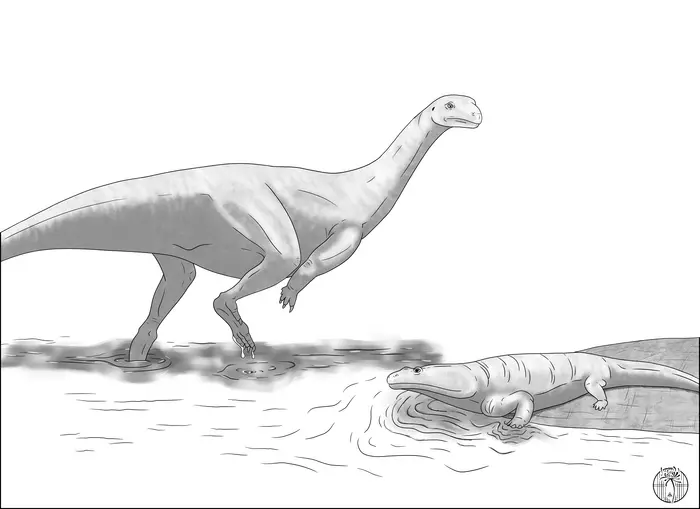A team of international scientists has unearthed a new dinosaur species, Musankwa sanyatiensis, on the shoreline of Lake Kariba in Zimbabwe. This remarkable discovery, set to be published in the journal Acta Palaeontologica Polonica, marks only the fourth dinosaur species named from the country and the first from the Mid-Zambezi Basin in over half a century.
The fossils, dating back approximately 210 million years to the Late Triassic period, consist of a single hind leg, including the thigh, shin, and ankle bones. Despite the limited remains, Dr. Kimberley ‘Kimi’ Chapelle, assistant professor at Stony Brook University and an honorary associate at the Evolutionary Studies Institute at Wits, notes that “these bones possess unique features that distinguish them from those of other dinosaurs living at the same time.”
Musankwa sanyatiensis: Named After a Houseboat and a Tonga Dialect Word
The newly discovered species was named Musankwa sanyatiensis after the houseboat “Musankwa,” which served as the research team’s home and mobile laboratory during two field expeditions to Lake Kariba in 2017 and 2018. In the Tonga dialect, “Musankwa” means “boy close to marriage.” The vessel was made available to the team through the generosity of David and Julie Glynn, and the crew – Coster Katupu, Godfrey Swalika, Simbarashe Mangoroma, and Never Mapira – provided essential logistic support.
Evolutionary analysis reveals that Musankwa sanyatiensis was a member of the Sauropodomorpha, a group of bipedal, long-necked dinosaurs widespread during the Late Triassic. Interestingly, this plant-eating dinosaur, weighing around 390 kg, appears to be closely related to contemporaries in South Africa and Argentina.
Africa’s Untapped Potential for Paleontological Discoveries
While Africa has a long history of dinosaur discovery, with the first dinosaur in the southern hemisphere found in South Africa just three years after the term “dinosaur” was coined in 1842, most known dinosaur fossils have been found in just 10 countries, particularly in the northern hemisphere. Prof. Paul Barrett from the Natural History Museum in London attributes this underrepresentation of African dinosaur fossils to “undersampling,” stating that “there have been fewer people looking for and unearthing dinosaurs in comparison with other regions of the world.”
Despite the fewer discoveries, many African fossils are historically and scientifically significant, including some of the oldest dinosaurs and rich dinosaur faunas from various countries. The Late Triassic-Early Jurassic sediments of Zimbabwe are crucial for understanding the End-Triassic extinction, a catastrophic event that dramatically reshaped Earth’s biodiversity around 200 million years ago.
The discovery of Musankwa sanyatiensis highlights the untapped potential of the region for further paleontological discoveries. Over the last six years, many new fossil sites have been recorded in Zimbabwe, yielding a diverse array of prehistoric animals. As more fossil sites are explored and excavated, there is hope for uncovering further significant finds that will shed light on the early evolution of dinosaurs and the ecosystems they inhabited. Dr. Kimi Chapelle excitedly explains, “Based on where it sits on the dinosaur family tree, Musanwka sanyantiensis is the first dinosaur of its kind from Zimbabwe. It, therefore, highlights the potential of the region for further palaeontological discoveries.”
If our reporting has informed or inspired you, please consider making a donation. Every contribution, no matter the size, empowers us to continue delivering accurate, engaging, and trustworthy science and medical news. Independent journalism requires time, effort, and resources—your support ensures we can keep uncovering the stories that matter most to you.
Join us in making knowledge accessible and impactful. Thank you for standing with us!

